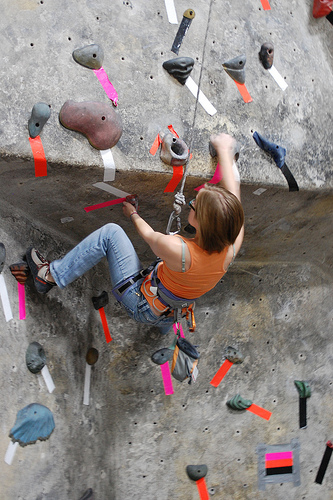
Breathe in. Breathe out. Just keep breathing. Almost to the top. I can do this.
My forearms burn with the effort of holding on to sandpaper-like surfaces. I lean to the right, fully extending my left arm out to my side. I twist my right hip into the wall, facing my outstretched arm and the corner just beyond. My right forearm gets a temporary respite as I instead push down on the hold located at my waist. With both arms extended, I place first one foot on the opposite wall of the corner. I then walk my second foot slightly higher along that same sidewall.
A quick glance down shows midget sized people 5 stories below. Even the climbers standing on the second level up are 3 and a half stories below me. My heart thuds heavier in my chest at the sight.
Oops, don’t look down. Never look down. Stay focused on the wall in front and above me. Remember to breathe.
With my weight mostly supported by my straight arms, I walk up the side wall, pivoting on my left hand. A little bit higher now, I move my right foot back along the wall my hands are on. My first attempt at placing my foot on the hold slightly below my bum fails. I strain to move my leg even higher, allowing my foot purchase on the half-inch surface of the hold. Straightening that leg, I stand up and grab the hold that was previously four feet above my head.
That section was the most fun, and the most challenging, part of my first climb last night.
My husband and I rock climb about once a week, and have been for the past 8 years. I have to admit that for the past 2.5 years, I have not really been challenging myself while climbing. My rule was that I had to go, and I had to climb for at least 1 hour and 4 routes. I could climb the easiest routes in the gym, but I had to climb. You see, climbing takes will, and I had used all my will during the business day.
But the opening of Vertical Endeavors Minneapolis made it considerably harder for me to not challenge myself. Built in a historic Ice House, routes stretch 50 to 60 feet up to the ceiling. VE Minneapolis’s roughly 6 story height make it intrinsically more challenging than the older St Paul gym’s 2 to 3 stories.
But I still chose routes that challenged me only in height, and not in technique.
Last night was different. The climbing gym was busy, and we didn’t feel like waiting for routes. For my husband’s first climb, he chose a route that had not yet been labeled with its difficulty rating. It looked doable, albeit slightly harder than what I had been doing lately. I watched him climb, evaluating the difficulty. After he finished with ease, he encouraged me to give it a try.
And I completed the route, as described above. After that route, we still didn’t feel like waiting, so we decided to lead climb.
Most routes in the gym are top rope, meaning the rope is anchored at the top. This allows your belayer to catch you with very little actual fall. With lead climbing, you bring the rope up with you, clipping in to anchors as you go. Accordingly, you are often above your anchor. If you fall, you will fall past your last anchor, and then again that same distance before your rope stops your fall. Although the lead routes may not be harder than the top rope routes, that increased distance of falling adds a mental degree of challenge. I think it’s scary. We don’t do it very often.
But since it was busy last night, we lead climbed. I led two routes, both of which displayed no difficulty rating because of the recent competition the gym hosted. My final climb was the only climb of the night that displayed a difficulty rating, and by that point I picked a 5.7, an easy route suitable for beginners.
Overall, it was a very good night of climbing. I thoroughly enjoyed the evening.
In adventure-based and experiential education, such as that offered by Outward Bound, NOLS, or other adventure companies, there is a theory called Challenge by Choice. It states that everyone has the right to choose their degree of challenge, free from peer pressure. Challenge by Choice is on the opposite side of the spectrum than the theory called Force Challenge, used in places like military boot camp where there is no choice whatsoever. If a participant has a choice, but they are pressured into something they might not otherwise do, that falls in the middle of the spectrum. Climbing wise, I had been firmly on the Challenge by Choice side of the spectrum, choosing a lack of challenge.
But last night was different. It was busy, and many routes still didn’t have ratings. Would I have climbed so hard if I knew the routes’ ratings? Would knowing that they were harder than what I had been climbing scared me away? Probably. If the gym had not been so busy, would we have lead climbed? No.
External pressures had caused me to increase my level of challenge. And I thrived. Last night, a bit of external pressure had been a good thing.
So, what do you think? Where do you fall on the spectrum of Challenge by Choice vs. Force Challenge? Let me know in the comments below.



Leave a Reply